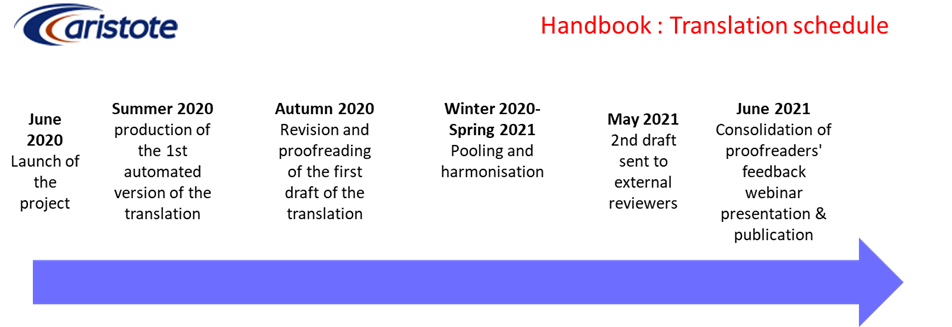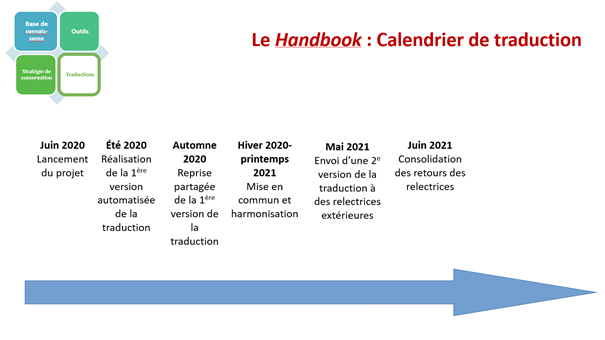[la version française suit]
Since 2019, France has had a Cellule Nationale de Veille sur les formats (National Formats Watch Unit), under the aegis of the French association Aristote and its working group on the Preservation of Digital Information (PIN). The Cellule currently brings together a dozen private and public partners. Its main objectives are to share monitoring activities on formats, to raise awareness among professionals on the subject, and to contribute to or influence the associated tools. It aims to be a recognised French-speaking interlocutor in international work on these subjects.
The Cellule is composed of working groups dedicated to different subjects:
-
Knowledge of file formats;
-
Identification of experts in the field of digital preservation;
-
Inventory of tools and datasets;
-
Translation of reference documents.
It is within this framework that the Digital Preservation Handbook of the Digital Preservation Coalition (DPC) has been translated.
Translation work of the Cellule
Since its creation, the translation group has already carried out
-
The translation of the National Digital Stewardship Alliance assessment grid
-
The translation of the DPC Rapid Assessment Model
In 2020, during the preparation of the Cellule’s roadmap, it became clear that the French translation of the DPC's Digital Preservation Handbook was essential, given the reference nature of this manual. The members of the working group carried out the French translation of the handbook between July 2020 and January 2021 on the basis of an initial translation accomplished automatically using the software Deep-L. The text was then proofread by experts other than the translators, resulting in a stabilised version in April-May 2021.

The manual was translated into French by : Marion Humbert (Archives départementales de la Moselle/Departmental archives of Moselle), Anne Jolly (Ministry of the Armed Forces), Thomas Ledoux (Bibliothèque nationale de France/National Library of France), Wilfried Prieur (Ministry of the Armed Forces), Stéphanie Roussel (Mintika), Édouard Vasseur (Ecole nationale des Chartes/National School of Charters).
Translation and adaptation issues
All translation work raises questions and involves making choices, in particular to transpose Anglosphere archival or preservation concepts to the French context. Among the most emblematic choices, we can note for example
-
The translation of Archive by Archive (in the OAIS sense) or ‘entrepôt numérique’/data warehouse (depending on the context);
-
The non-translation of Cloud and Dark Archive;
-
The translation of Digital material as 'objet numérique’ and of Digital preservation as ‘préservation numérique’
-
The translation of Forensics as ‘criminalistique’
-
And finally, the translation of Repository as ‘entrepôt numérique’.
The group made these choices with the aim of ensuring the best possible readability of the text by all professional communities. The presence of archivists and librarians in the group greatly facilitated the work.
Adapting the manual to the French context
One of the interests of the manual is the extensive lists of reference resources. Naturally, most of these resources are linked to the Anglosphere context in which the manual was written. The translation group has chosen to maintain these resources, while supplementing them with elements specific to the French context. The additions have been indicated in the translation.
More generally, some chapters, such as those dedicated to compliance with legislation or to the preservation of specific content, have been translated as they are, but will largely have to be adapted to the French context. On the other hand, some chapters are of particular interest in the French context because they are subjects that are not yet widely addressed in France. This is the case, for example, of the chapters on profitability analysis and forensic science.
Presentation of the translation
The French translation of the handbook was the subject of a first presentation organised as part of the PIN group's webinars. This webinar was attended by more than 100 participants, all of whom showed interest in the work presented.
The webinar can be viewed at: https://www.association-aristote.fr/webinaire-pin-formats-digital-preservation-handbook/
Other translation projects
The translation of the handbook has been a major undertaking. The translation group will continue to work in directions that are currently being discussed within the Cellue.
Amongst these, the translation of the updates of the manual will be a priority. It is also planned to translate other documents produced by the DPC, such as the Tech Watch Report and the Guidance notes.
This translation work is essential to make digital preservation knowledge available to the widest possible audience.
Présentation de la traduction française du Digital Preservation Handbook
Depuis 2019, la France s’est dotée d’une Cellule nationale de veille sur les formats (CNVF), sous l’égide de l’association française Aristote et de son groupe de travail sur la Pérennisation de l’information numérique (PIN). La Cellule regroupe à ce jour une douzaine de partenaires. Elle a pour principaux objectifs la mutualisation des activités de veille sur les formats, la sensibilisation des professionnels sur le sujet, la contribution ou l’influence sur les outils associés. Elle ambitionne d’être un interlocuteur francophone reconnu dans les travaux internationaux sur ces sujets.
La Cellule se compose de groupes de travail dédiés à différents sujets :
-
La connaissance des formats de fichiers ;
-
L’identification des experts en matière de préservation numérique ;
-
Le recensement des outils et des datasets ;
-
La traduction de documents de référence.
C’est dans ce cadre qu’a été traduit le Digital Preservation Handbook de la Digital Preservation Coalition.
Les travaux de traduction de la Cellule de veille sur les formats
Depuis sa création, le groupe traduction a déjà effectué :
-
La traduction de la grille d’évaluation de la NDSA
-
La traduction du Rapid Assessment Model du DPC
En 2020, à l’occasion de l’élaboration de la feuille de route de la cellule, il est apparu que la traduction française du Digital Preservation Handbook de la DPC devenait incontournable, en raison du caractère de référence de ce manuel. Les membres du groupe de travail ont réalisé la traduction française du manuel entre juillet 2020 et janvier 2021 sur la base d’une première traduction effectuée de façon automatisée grâce au logiciel DeepL. Le texte a ensuite été relu par d’autres experts que les traducteurs, ce qui a permis l’établissement d’une version stabilisée en avril-mai 2021.

Le manuel a été traduit en français par : Marion Humbert (Archives départementales de la Moselle), Anne Jolly (ministère des Armées), Thomas Ledoux (Bibliothèque nationale de France), Wilfried Prieur (ministère des Armées), Stéphanie Roussel (mintika), Édouard Vasseur (Ecole nationale des Chartes).
Questions de traduction et d’adaptation
Tout travail de traduction pose des questions et implique de réaliser des choix. Parmi les choix les plus emblématiques, nous pouvons noter par exemple :
-
La traduction d’Archive par Archive (au sens OAIS) ou entrepôt numérique (en fonction du contexte) ;
-
La non-traduction de Cloud et de Dark Archive;
-
La traduction de Digital material par l’expression « objet numérique » et de Digital preservation par « préservation numérique » ;
-
La traduction de Forensics par « criminalistique » ;
-
Et en fin, la traduction de Repository par « entrepôt numérique ».
Le groupe a effectué ces choix avec pour objectif d’assurer la meilleure lisibilité possible du texte par toutes les communautés professionnelles. La présence d’archivistes et de bibliothécaires en son sein a grandement facilité le travail.
Adaptation du manuel au contexte français
L’un des intérêts du manuel tient aux listes très fournies de ressources de référence. Naturellement, ces ressources sont pour la plupart liées au contexte anglo-saxon de rédaction du manuel. Le groupe de traduction a choisi de maintenir ces ressources, tout en les complétant d’éléments propres au contexte français. Les compléments ont été signalés dans la traduction.
Plus généralement, certains chapitres, tels que ceux dédiés au respect de la législation ou à la préservation des contenus spécifiques ont été traduits tels quels, mais devront largement être adaptés au contexte français. À l’inverse, certains chapitres présentent un intérêt particulier dans le contexte français car ce sont des sujets encore peu abordés en France. C’est par exemple le cas des chapitres dédiés à l’analyse de rentabilité ou à la criminalistique.
La présentation de la traduction
La traduction française du manuel a fait l’objet d’une première présentation organisée dans le cadre des webinaires du groupe PIN. Ce webinaire a réuni plus d’une centaine de participants qui ont tous fait preuve de leur intérêt pour les travaux présentés.
Le webinaire peut être revu à l’adresse suivante : https://www.association-aristote.fr/webinaire-pin-formats-digital-preservation-handbook/
Autres projets de traduction
Le travail de traduction du manuel a constitué un chantier de grande ampleur. Le groupe de traduction va poursuivre ses travaux selon des directions en cours de discussion au sein de la Cellule.
Parmi celles-ci, la traduction des mises à jour du manuel sera prioritaire. Il est également envisagé de traduire d’autres documents produits par la DPC comme les Tech Watch Report et les Guidance notes.
Ces travaux de traduction sont indispensables pour mettre à la disposition du plus grand nombre les connaissances en matière de préservation numérique.

Comments